Exploring the Island Chains off Cartagena, Colombia
By Ruth Emblin
Editor’s note: Part 1 of Ruth’s article appeared in our June edition and can be found at https://www.windcheckmagazine.com/article/blue-water-and-islands-everywhere/
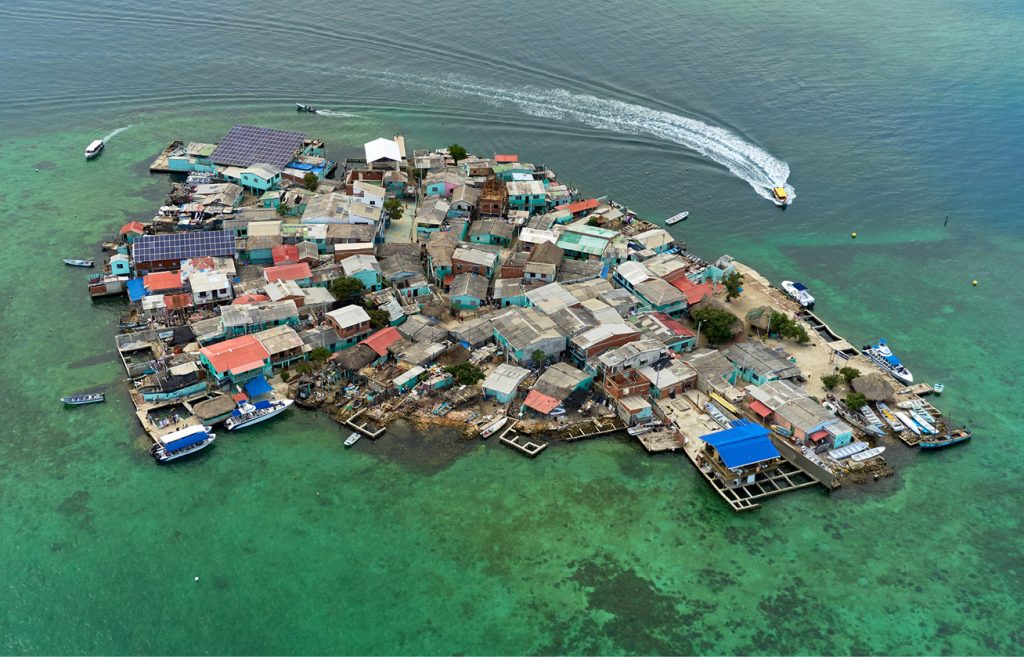
Santa Cruz del Islote has the second-highest population density in the world. © Patrick Lemaret
On our way back to Tintipán we passed Santa Cruz del Islote, a tiny island completely devoid of vegetation, covered from end to end in buildings. A friendly resident we spent an evening with after we expressed interest in finding out more about the history of this unusual islet told us that the island is partially artificial. It was built on coral outcroppings with little soil and vegetation by fishermen from the area of Barú who were attracted not only by the abundant fishing grounds but also wanted to flee the coast’s mosquito plague and resulting diseases. By razing all remnants of vegetation from the island, building it up with coral, stone, and other materials, and constructing their homes on the resulting platform they began to create a tight-knit community.
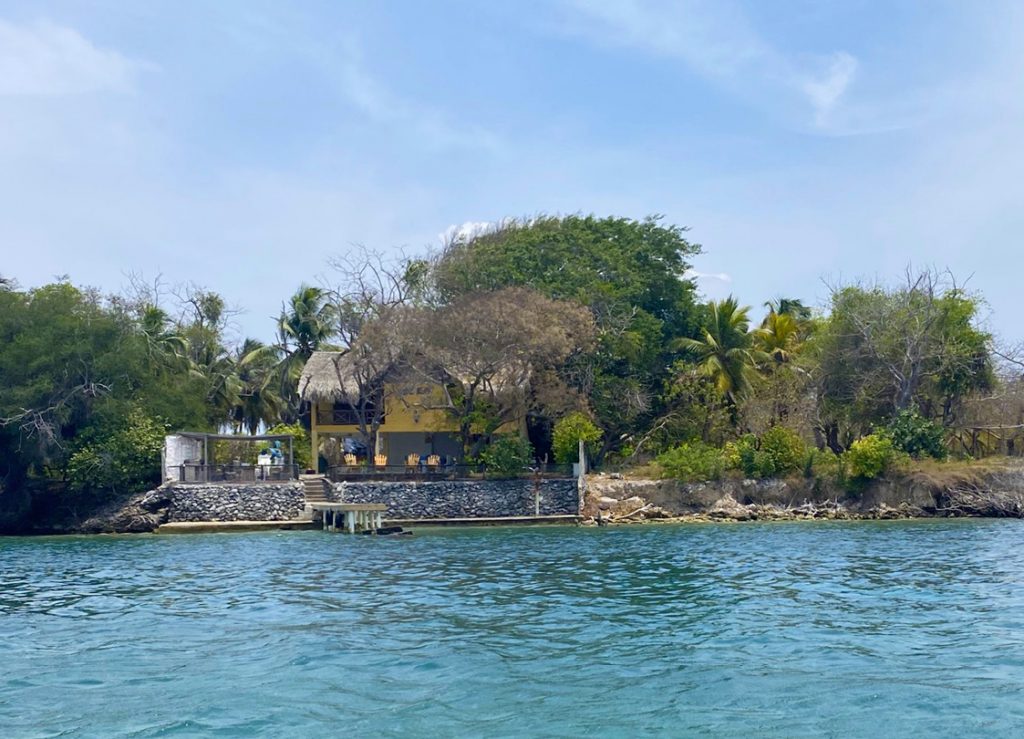
Isla Marina
Founded in the late 19th century, people from the surrounding areas and even some other countries began to make Islote their home. It is still growing, but due to its size restrictions, some residents have left to live on the nearby islands. There are about 90 houses, one or two shops, a hostel, a school, a restaurant, and even a disco on the tiny island. Most of the residents are fishermen or work in nearby hotels. Water is brought in by barge, and a generator provides electricity for a few hours a day. On special occasions, such as during all-important soccer championships, the islanders pool their funds to buy extra gasoline to generate electricity for their televisions. Apparently, Santa Cruz del Islote has the second-highest population density in the world after Macao.
After spending a few days in the San Bernardo chain, we decided to make our way slowly back toward Cartagena. We only had a few days left before our flight back to the U.S. and we still wanted to explore the other islands a little more closely. We sailed northwards, sadly mostly with the wind on the nose, until we reached Isla Grande, the largest in the Rosario Chain. Since it is so close to Cartagena and a popular vacation destination, Isla Grande boasts a number of hotels, from luxury to modest, as well as a number of basic hostels. The area is known for its bioluminescent plankton that lights up if agitated, and there are several lagoons on Isla Grande where you can experience this phenomenon at night.
We safely passed through the reef just outside the approach and anchored on the southeast side near the Hotel Cocoliso. Anchoring was a bit of a challenge due to the wind predictions for the next couple of nights, though we dragged only a little bit during our first overnight.
We jumped into our dinghy and went exploring. A little further to the west were Isla Marina and a few smaller cays surrounded by brightly sparkling turquoise waters. One of the cays hosts the Oceanario Islas del Rosario, an outdoor “aquarium.” I regret that we did not have time to go scuba diving in the Rosario islands, as we heard that the reefs and fisheries there are still very intact and protected by the Coral Islands National Park. We may have to plan another trip with more time…
Isla Marina and the west coast of Isla Grande are quite densely built up with homes, hotels, and restaurants of all types and sizes. By law, island properties can only be owned by locals but are often leased out to wealthy individuals who build stately vacation homes. Imagine our surprise as we floated past an immense, derelict-looking estate, built in an upscale palapa style, only to be confronted by a very large, very obvious no-trespassing sign. The sign further informed us that the property had been repossessed by the Colombian government. Just around the corner, yet another two properties were similarly restricted. A bit of research showed that these houses used to be owned by certain nefarious Colombian drug lords who had luxurious homes all over the country. Yet this dark history doesn’t seem to have affected today’s hustle and bustle of Isla Grande; right next door was a colorful restaurant with waterslides and a happy crowd dancing to Latin tunes on a terrace overlooking the water.
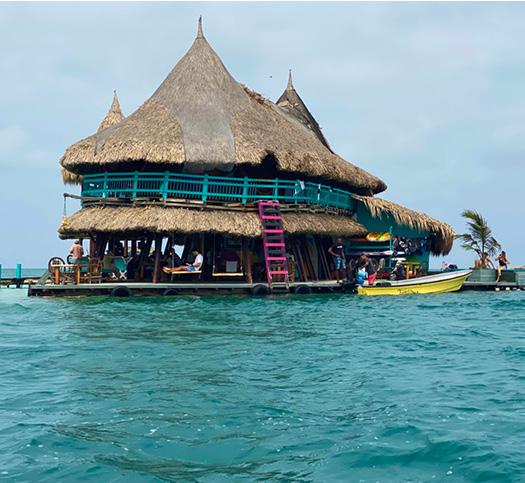
Casa en el Aqua
Many of the islands still show the after-effects of Hurricane Iota, a powerful late-season storm that hit Central and South America in 2020. We all are aware of supply-chain issues at home, so it comes as no surprise that this area still bears the scars of this storm, compounded by the distance from the mainland. The region was, however, much luckier than San Andrés and Providencia, two Colombian islands far to the northwest that sustained massive damage; Providencia to a point that the authorities proclaimed that 98 percent of its infrastructure had been wiped out. Nevertheless, sections of both the San Bernardo and Rosario Islands still bear witness to the destructive forces that hit them. Protective seawalls collapsed, the roofs of many buildings have ragged holes, and only pilings are visible where docks used to be. There is also the occasional skeleton of a boat that was swept onto land during the storm. Between the distance to the nearest suppliers, the effects of the pandemic, worldwide material shortages and, of course, “island time,” it will be a while until everything goes back to normal.
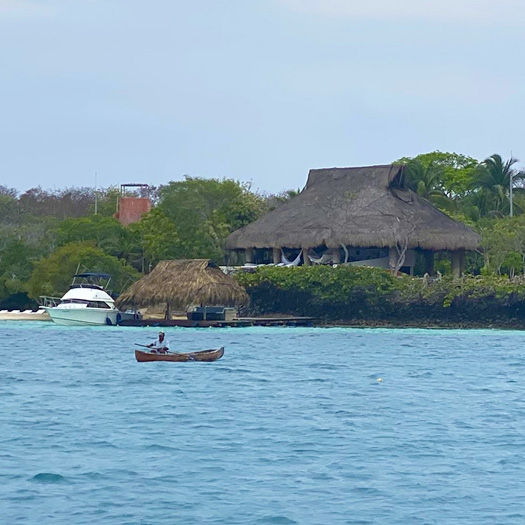
A typical resort building
Thanks to a malfunctioning icebox on our charter boat we had run out of ice very quickly and went in search of replenishment. Ice is a very jealously guarded commodity on the islands, as both water and ice have to be brought over from the mainland on a water barge. While most houses have cisterns, it usually only rains consistently from May to November. The water barge goes from island to island to supply the homes and guest houses. Only a few upscale hotels have reverse osmosis systems to turn seawater into fresh water. We had to return empty-handed, though were able to stock up on beer, and resolved to use up any of our perishables more quickly. The last night in Isla Grande happened to be my husband’s birthday, and we booked dinner at the Hotel Cocoliso nearby. We decided to stay the night to enjoy the dinner and a few drinks without having to worry about a dinghy ride. We also wanted to give our two crew members a chance to be by themselves. Little did we know that the same night an emergency would unfold just offshore and our boat feature in it front row and center!
As Charlie told us the next morning, his brother Kevin was sleeping on deck to keep an eye on the boat, since the wind had kicked up in the evening. None of us had a lot of confidence in the boat’s rather rusty anchor chain, and gusty conditions had been forecast for the night. At around 1 am Kevin heard someone shouting for help. He tried to locate where the shouting came from and realized that it was offshore. He woke his brother, and Charlie jumped into the dinghy and drove around to find whoever was clearly in need of assistance.
With just the light from his mobile phone, he located a man floating in the water. Charlie dragged the half-drowned man into the dinghy and brought him back to our boat. After providing him with a blanket and something hot to drink, the man was revived enough to share his story. He and a fellow fisherman had left the peninsula of Barú at 6 pm the same night to fish. When the weather started to turn, the winds began to increase sharply, and the sea state deteriorated. Their small fishing boat was overturned by a wave, and they were both swept away. Barú is approximately 6 nautical miles from Isla Grande. Both men floated in the water for several hours, until he lost sight of his companion. The Colombian Coast Guard arrived half an hour after the rescue, and took the man under their care. Thanks to Kevin’s vigilance and Charlie’s quick reaction, the man survived his ordeal to see another day. His fellow fisherman was not that lucky. His body was found the next day in the mangroves of one of the neighboring islands. The local newspaper in Cartagena ran a story about the two fishermen the next day, but unfortunately did not mention our crew’s heroic efforts.
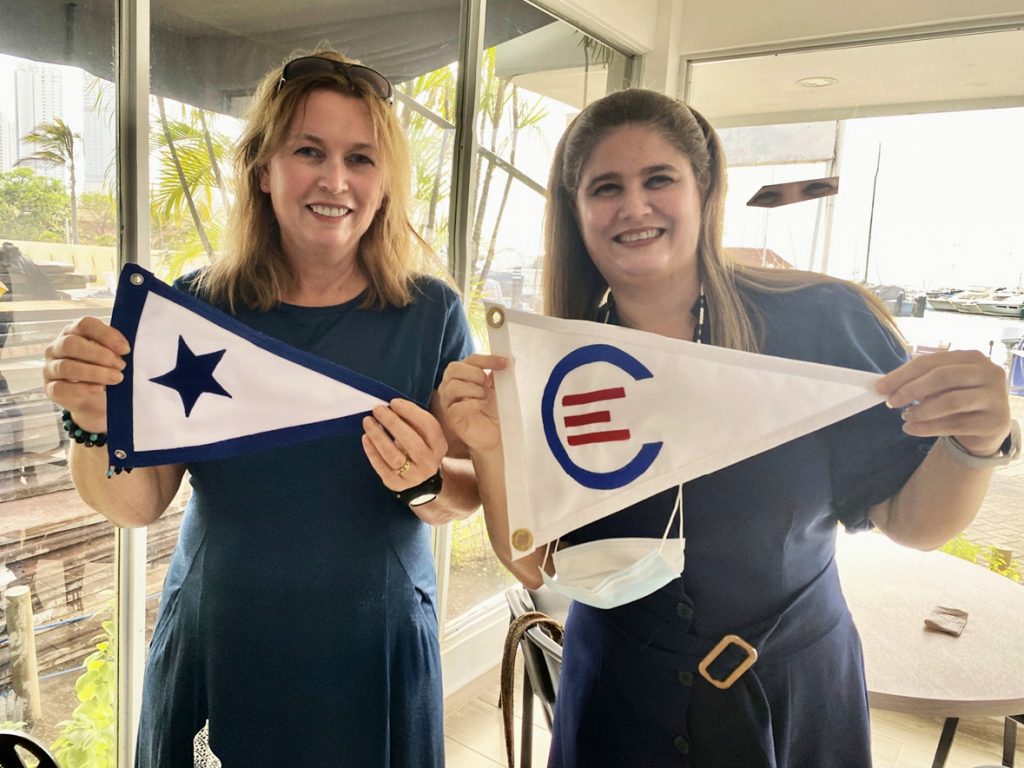
Exchanging burgees at Club de Pesca
After this sobering incident, we had to remind ourselves that the sea can be a cruel mistress. We cannot just take for granted that everything will always go our way. A certain amount of vigilance and understanding of the risks is required, whether one is a recreational sailor, powerboater, or commercial boater. It is wonderful to experience the atmosphere at sea, surfing down the waves and watching the wind fill the sails, but we can never forget to maintain a healthy respect for the elements. As we were sailing back to Cartagena we thanked our lucky stars that we had the privilege to safely enjoy our cruise around these beautiful, still rather wild and primitive islands.
On our way into the harbor, we were almost overtaken by a nasty squall with major lightning all around. We just squeezed back into our spot at the Club Nautico when the heavens opened up. Bags packed, we said goodbye to our crew and headed to rendezvous with my brother-in-law at the Club de Pesca Cartagena, a modern marina, fishing and yacht club just a few hundred yards away. Club de Pesca, with an impressive marina, clubhouse, and stunning waterfront dining area welcomed us with open arms.
We were invited on a tour of the facilities by Adriana, the Club Manager, who took time out of her busy schedule to show us around. Founded in 1938 as a fishing club, and later expanded into a marina and yacht club, Club de Pesca runs regular regattas from January through June, endorsed by the Colombian Sailing Federation, following the World Sailing Racing Rules. Typical regatta entries include everything from 24-foot to over 65-foot boats, pure-bred racers, performance cruisers, cruising boats, and daysailers. Depending on the conditions, courses are laid either around the buoys within the Bay of Cartegena, or offshore to and from the Rosario Islands. We capped off our visit with a traditional exchange of yacht club burgees and left the club hoping to return one day with our own boat.
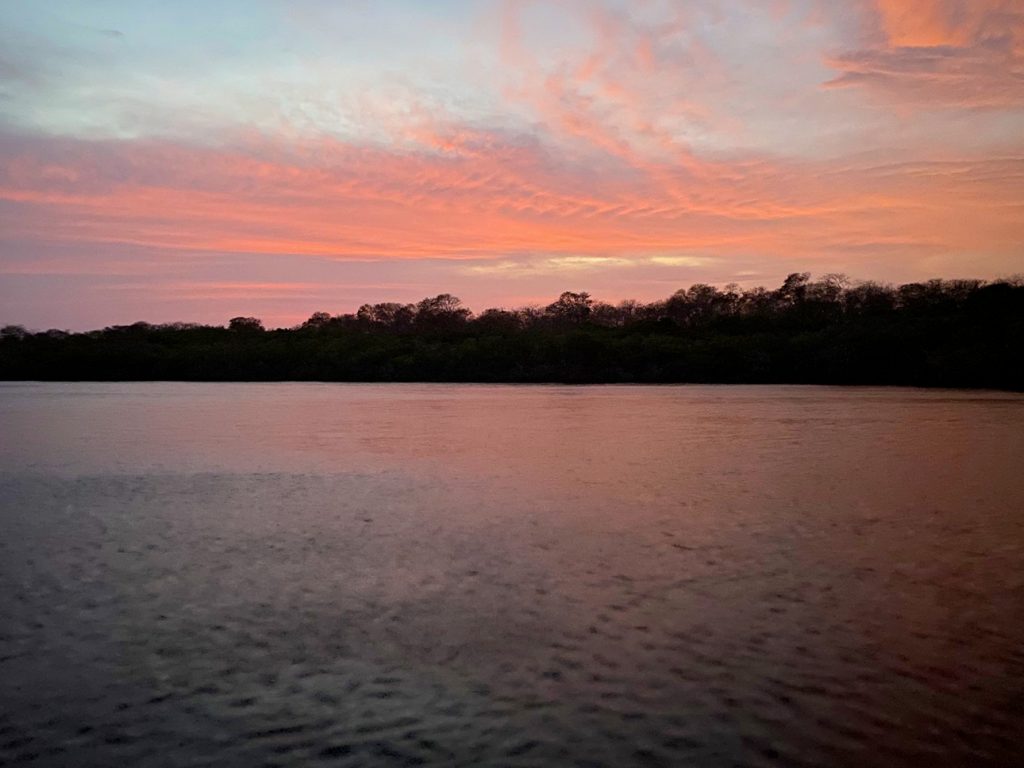
Sunset in the Caribbean’s “quiet corner”
We spent the last two days in a boutique hotel in the Old City of Cartagena and enjoyed a few more of the culinary delights of the city, before boarding a plane back to the United States. Cruising on a sailboat in Colombia is still in its infancy, and there really is not much infrastructure for cruising in the coastal region outside of Cartagena. However, if you take this into account and prepare accordingly, it is an amazing place to visit, far from the “usual” Caribbean most of us are used to. I will always remember the sunsets reflected on the crystal clear water while anchored outside mangrove-skirted islands with thatched palapas and tall palm trees on the shore. Our time in the islands just south of Cartagena had a certain kind of wild romance to it, which was essentially a welcome change from the utterly catered-to experiences in other parts of the Caribbean. We will be back one day soon! ■
Ruth Emblin is Vice Commodore of Duck Island Yacht Club, a Past Commodore of Essex Corinthian Yacht Club, and co-chair of the Gowrie Group CT River One-Design Regatta to benefit Sails Up 4 Cancer presented by Cooper Capital Specialty Salvage.



